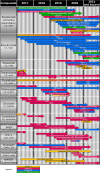Treatment of Rare Inflammatory Kidney Diseases: Drugs Targeting the Terminal Complement Pathway
- PMID: 33362783
- PMCID: PMC7758461
- DOI: 10.3389/fimmu.2020.599417
Treatment of Rare Inflammatory Kidney Diseases: Drugs Targeting the Terminal Complement Pathway
Abstract
The complement system comprises the frontline of the innate immune system. Triggered by pathogenic surface patterns in different pathways, the cascade concludes with the formation of a membrane attack complex (MAC; complement components C5b to C9) and C5a, a potent anaphylatoxin that elicits various inflammatory signals through binding to C5a receptor 1 (C5aR1). Despite its important role in pathogen elimination, priming and recruitment of myeloid cells from the immune system, as well as crosstalk with other physiological systems, inadvertent activation of the complement system can result in self-attack and overreaction in autoinflammatory diseases. Consequently, it constitutes an interesting target for specialized therapies. The paradigm of safe and efficacious terminal complement pathway inhibition has been demonstrated by the approval of eculizumab in paroxysmal nocturnal hematuria. In addition, complement contribution in rare kidney diseases, such as lupus nephritis, IgA nephropathy, atypical hemolytic uremic syndrome, C3 glomerulopathy, or antineutrophil cytoplasmic antibody-associated vasculitis has been demonstrated. This review summarizes the involvement of the terminal effector agents of the complement system in these diseases and provides an overview of inhibitors for complement components C5, C5a, C5aR1, and MAC that are currently in clinical development. Furthermore, a link between increased complement activity and lung damage in severe COVID-19 patients is discussed and the potential for use of complement inhibitors in COVID-19 is presented.
Keywords: ANCA-associated vasculitis; C3 glomerulopathy; C5 antagonist; C5aR1 antagonist; IgA nephropathy; aHUS; complement system; lupus nephritis.
Copyright © 2020 Ort, Dingemanse, van den Anker and Kaufmann.
Conflict of interest statement
MO, JD, and PK were employed by the company Idorsia Pharmaceuticals Ltd. The views expressed in this article are those of the authors and do not necessarily reflect those of their company. The remaining author declares that the research was conducted in the absence of any commercial or financial relationships that could be construed as a potential conflict of interest.
Figures


Similar articles
-
The membrane attack complex drives thrombotic microangiopathy in complement mediated atypical hemolytic uremic syndrome.Kidney Int. 2025 Apr;107(4):700-713. doi: 10.1016/j.kint.2024.12.016. Epub 2025 Jan 21. Kidney Int. 2025. PMID: 39848404
-
Complement Inhibitors in Clinical Trials for Glomerular Diseases.Front Immunol. 2019 Sep 27;10:2166. doi: 10.3389/fimmu.2019.02166. eCollection 2019. Front Immunol. 2019. PMID: 31611870 Free PMC article. Review.
-
Inhibiting the C5-C5a receptor axis.Mol Immunol. 2011 Aug;48(14):1631-42. doi: 10.1016/j.molimm.2011.04.014. Epub 2011 May 6. Mol Immunol. 2011. PMID: 21549429 Review.
-
[Role of Complement in Kidney Diseases - New Aspects].Dtsch Med Wochenschr. 2023 Jun;148(12):774-779. doi: 10.1055/a-1936-6697. Epub 2023 May 31. Dtsch Med Wochenschr. 2023. PMID: 37257480 German.
-
Differential contribution of C5aR and C5b-9 pathways to renal thrombic microangiopathy and macrovascular thrombosis in mice carrying an atypical hemolytic syndrome-related factor H mutation.Kidney Int. 2019 Jul;96(1):67-79. doi: 10.1016/j.kint.2019.01.009. Epub 2019 Feb 27. Kidney Int. 2019. PMID: 30910380 Free PMC article.
Cited by
-
Proteomics and bioinformatics analysis of follicular fluid from patients with polycystic ovary syndrome.Front Mol Biosci. 2022 Aug 22;9:956406. doi: 10.3389/fmolb.2022.956406. eCollection 2022. Front Mol Biosci. 2022. PMID: 36072434 Free PMC article.
-
Hemolytic uremic syndrome in the setting of COVID-19 successfully treated with complement inhibition therapy: An instructive case report of a previously healthy toddler and review of literature.Front Pediatr. 2023 Feb 15;11:1092860. doi: 10.3389/fped.2023.1092860. eCollection 2023. Front Pediatr. 2023. PMID: 36873657 Free PMC article.
-
Serum and plasma levels of Ba, but not those of soluble C5b-9, might be affected by renal function in chronic kidney disease patients.BMC Nephrol. 2023 Feb 2;24(1):26. doi: 10.1186/s12882-022-03022-z. BMC Nephrol. 2023. PMID: 36732701 Free PMC article.
-
Pediatric Atypical Hemolytic Uremic Syndrome Advances.Cells. 2021 Dec 18;10(12):3580. doi: 10.3390/cells10123580. Cells. 2021. PMID: 34944087 Free PMC article. Review.
-
Modeling time-delayed concentration-QT effects with ACT-1014-6470, a novel oral complement factor 5a receptor 1 (C5a1 receptor) antagonist.Pharmacol Res Perspect. 2023 Aug;11(4):e01112. doi: 10.1002/prp2.1112. Pharmacol Res Perspect. 2023. PMID: 37470156 Free PMC article.
References
-
- Janeway C, Travers P, Walport M, Shlomchik M. The complement system and innate immunity. 5th ed. (2001) Immunobiology: The Immune System in Health and Disease. New York: Garland Science.
Publication types
MeSH terms
Substances
LinkOut - more resources
Full Text Sources
Other Literature Sources
Medical
Research Materials
Miscellaneous

